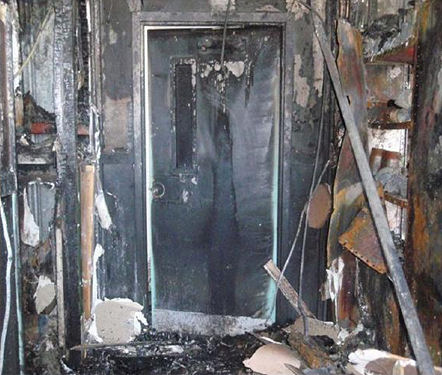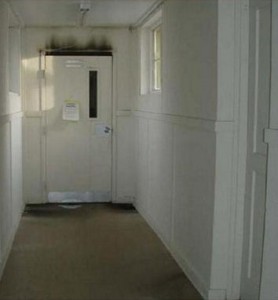Sometimes I feel like a broken record. Like maybe people are sick of hearing me talk about fire and egress doors, how they protect us, and what happens when they are disabled or neglected. When I meet someone, I don’t immediately launch into a discussion about doors because I’m pretty sure they’ll think I’m a weirdo from the start and probably avoid me the next time.
Well, I have a friend who’s a high school principal. Over the holidays we were at a Christmas party together and for some reason we were talking about what time we go to bed. He asked me why I stay up so late so I told him a little about my work and my blog. He was fascinated! Seriously…he had never really thought much about doors, and was shocked that I stay up late answering emails from all over the US and beyond. His perspective was interesting, because in my opinion a high school principal should know the basics about fire doors and egress doors. The truth is…most people have never given them a thought.
I saw the photos below in a webinar conducted by Bill Johnson and Keith Pardoe of the Door Security & Safety Foundation, and I think they’re the best illustration of the value of a fire door that I’ve ever seen. The photos were shared with Bill by Paul Martin of the Center for Campus Fire Safety, a non-profit organization devoted to reducing the loss of life from fire on college campuses. If this door had been propped open with a wood wedge, as so many fire doors are, it wouldn’t have been able to help contain the smoke and flames. The damage to the corridor and the rest of the building would have likely been much greater. The means of egress could have become impassable, trapping building occupants.
This is not rocket science, people. Fire doors that are functioning properly protect lives and property. Fire doors that have been damaged, neglected, or improperly modified will not offer the same protection. Code-compliant egress doors facilitate the safe exit of building occupants. Egress doors that have non-compliant security devices or that don’t operate properly could result in building occupants spending crucial time trying to locate another exit. Sometimes they don’t find one in time.
I don’t advocate for the annual inspection of fire and egress doors because I want to inspect doors (I don’t). I talk about it because even though the codes and standards have always required these doors to be kept in compliance, many are not. The inspection requirements help ensure that non-compliant doors are repaired. That’s it.
I feel like we might be making some progress though. This week I have 3 meetings with facilities that want to learn more about fire door inspection – a hospital, a medical school campus, and a government agency. These meetings were not the result of any sort of advertising campaign or “blitz”…they came about because of relationships begun or enhanced by this blog. Maybe my little hobby will eventually have a measurable impact on fire and egress door safety.
Speaking of fire door safety and finally getting around to the $63,000 post title…I posted a link to an article a couple of weeks ago (300 forced out by fire), in which the fire chief said that the door to the apartment where the fire originated wasn’t working properly and didn’t close completely. I asked the fire chief about it but he said that he couldn’t give me a lot of information at that point because there would be charges filed in relation to the defective door. I saw this article on Friday, regarding a different fire in the same city:
Company fined due to fire in St. Catharines.
Rick Fleming 610 CKTB News – 1/20/2011
Due to a fire at a Geneva Street high-rise in St. Catharines, a property-management company from Mississauga has been slapped with a fine of just under 63-thousand dollars.
Trans-Globe Property Management pleaded guilty to failing to maintain smoke alarms and proper fire-door closure devices in the ten-story building.
The blaze erupted this past September. After it was doused, fire-fighters found that the smoke alarms didn’t work, and they ordered a full inspection of the structure.
St. Catharines Fire Chief Mark Mehlenbacher is quite pleased with the punishment, adding that the fire department will chase anyone or any organization down who fails to maintain, tampers with, or disables any fire-safety equipment.
There were 3 high-rise apartment fires in St. Catharines between mid-December and mid-January, one of which was the fire where the apartment door didn’t close. The most recent article is in reference to a 4th fire, so I’m guessing there could be more fines to come. $63,000 would surely have paid for a fire door inspection many times over. Not to mention the hundreds of thousands of dollars in property damage and lost rental income.
Photos courtesy of Paul Martin, president of the Center for Campus Fire Safety.
You need to login or register to bookmark/favorite this content.









I printed those pictures and taped them to my office door. What an awesome illustration of what a fire door does!
Hi Lori,
These are great photos. Rarely do we see the fire and non-fire side of a door in a real life fire situation, and especially with a narrow vision frame (my area of great interest). As you may know, we have an educational seminar that we put on for DHI chapters, architects and customers that pertains mainly to glass and glazing for fire and safety doors, and these photos would be a great addition to our presentations. May I have your permission to use theses two photos? If so,could you possibly send me the original files?
By the way, I try to read every blog and article that you write, so at least your late night efforts are not going unnoticed in California. Thanks, Ron Hansen-Anemostat
hello Lori, 2 great photos to show how effective a properly maintained fire door can be when a fire breaks out, i know in the push side (singed and black) photo shows the door closer oil (darker black on door) that has been heated up and leaked out of the closer during the fire, to many, they think the closer may have not passed the inspections, they do say (as part of positive pressure fire testing) that a closer can leak its oil, as long as the oil does not ignite and add more “fuel” to the fire (yea, closer fluid is inert, meaning it doesnt cause any explosions or make a fire worse). the shiny spot on floor on pull side, under kick plate, I see more closer fluid.
even though it don’t appear to be an IR product, it still did it’s job and kept people safe, hopefully this closer is or was a rebuildable one, (like LCN 4000 series are)
Ron Hanson, I have seen this photo on flickr (yahoo photos) I remember it was the flickr account of a fire door inspection guy, I don’t remember were from.
-Jess
Thanks, Jess. I’ll search around a bit.
Ron Hansen
Hello to every body, it’s my first visit of this blog; this blog contains amazing and
genuinely excellent stuff designed for readers.
Hello Ron,
You may remember me from my days with a hardware company in Minnesota. This is a great article and unfortunately most of the time the only people that don’t think we’re wierdos are the ones from the industry. There needs to be more education on these types of situations, in these areas where people likely are propping hollow metal or wood doors open in commercial/tenant building settings. Seminars are great, but some day the schooling needs to apply to building managers and their tenants. I am pleased to see that someone of your stature is involved with this.
Toby
maybe a 10 commandments of fire doors type flyer might work? it could be laminated for school stationary engineers or a copy for janitors to show teachers that floor stops are never allowed on fire doors!
Lori keep up the good work!
i’m going over safety at my job and it appears we have many violations that need to corrected ASAP. currently, i am writing a report but I wanted to know if you could tell me what the full penalty is for blocked fire doors as well as fire doors that are not operational. thank you in advance
Hi Junior –
That varies by jurisdiction and can sometimes even depend on the individual who is acting as the AHJ.
– Lori